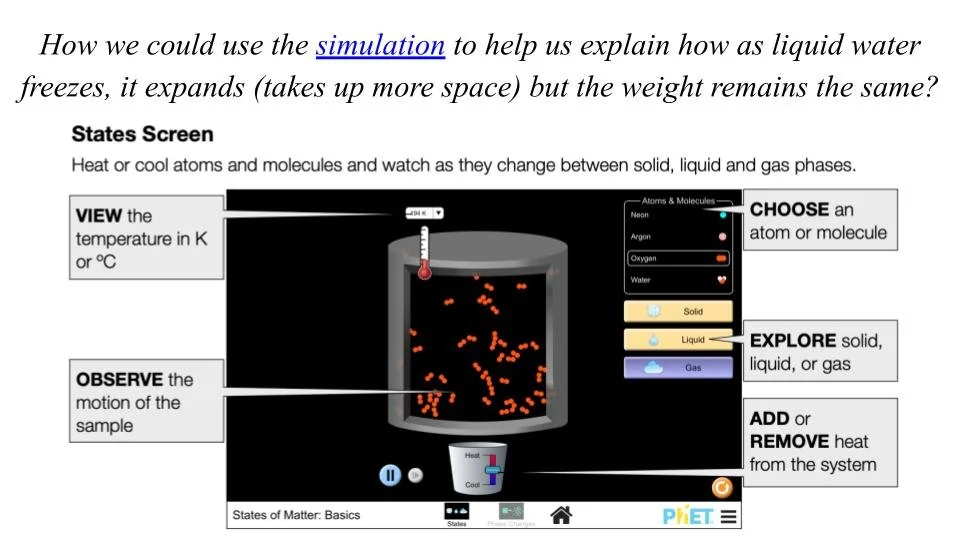How to identify mechanisms
Often, results help scientists identify factors that matter, but they may still be unsure about why or how those factors make a difference. They have to engage in conceptual work and may need to bring other sources of information to bear on their findings. Engaging students with considering mechanisms helps them apply science ideas to explain their findings and can support the development of further puzzles and the use of resources to address new puzzles.
A closer look at uncertainty in the classroom
After freezing and weighing water in vials and claiming that as water freezes, it expands but stays the same weight, students revisit their initial models of bottles breaking when frozen. They experience and work productively with uncertainty about mechanisms as:
Students recognize where their initial models contradict their findings
Students see a new puzzle in their models
The class explores a new resource to make progress on their puzzle
Students recognize where their initial models contradict their findings.
In small groups, students look again at two models drawn before the investigation. They recognize the limitations of Rafael’s model in light of their finding that water expands when frozen.
Rafael: Something first that I need to say is that like the water level of the second one and the third one needed to be bigger than the first one because I drew the bottle bigger and then put the water level in the first one higher.
Santiago: The molecules on the first bottle they are spread from the sides and the second picture they are getting closer and on the third picture the bottle explode and the molecules is all together.
Victoria: A lot of people said that in the second drawing they are separating and exploding, but like we can see in the drawing there they are coming together. So how are they exploding and then come together.. so I’m asking…. this is my question because I don’t know if they exploded or came together.
Santiago: When the molecules on Rafael's drawing the molecules are in the middle that is why I think the air is making the pressure but when I look at Sada’s drawing, I change my mind because I think the air stays at the middle of the bottle and the molecules make the pressure at the glass
Rafael’s Model
Sada’s Model
Students see a new puzzle in their models
Victoria: “I don’t know the weight of this water bottle... because it is a drawing.”
Lindsay points at Sada’s model that seems to show more molecules, “How can we look at weight when we look at these water bottles?
Rodrigo: I think it stays the same and is heavier. Because like the molecules are light... The molecules in the first one like stay like, Como se diz mais leve? [How do you say lighter?]
Multiple students: Light
Rodrigo: Because the first one has not- Como se diz naomuy menos [How do you say much less?]
Other Students: Not as much; not as many; Because the first one has not as much as the next one.
Rafael: One question I have is like how does the molecules…how does the last one have more molecules than the first one? (audible agreement from other students; several hands raised)… Because like that's like crazy to think about how does the molecules- how does when it turns to ice get more molecules and where does the molecules come from?
Discussing how Sada’s model could show weight sparks an explosion of ideas as students connect molecules and weight.
The class explores a new resource to make progress on their puzzle
The teacher asks the students to think about how the simulation can help them answer their remaining puzzle.
With a puzzle established — how can water molecules explain water level increasing; do they multiply? — the class uses a simulation to help them make progress. They count molecules. Some students use snap cubes to represent how the same number of molecules can rearrange to create a lattice-like structure that takes up more space than the moving liquid molecules.
Instructional moves to support this form of uncertainty
In designing investigations, recognize that investigations rarely provide definitive mechanisms for results. Consider uncertainty that may arise and resources that might be useful for addressing uncertainty.
Use pen-and-paper models to encourage students to consider and link macro and micro aspects of phenomena.
Listen for markers of explanatory work: “because,” “how does…” “it doesn’t make sense that…” Orient to moments of uncertainty about mechanisms.
Use findings from investigations to establish puzzles about how or why results occurred, then introduce other resources to help students make progress on puzzles
Where else does this form of uncertainty come up?
Explore Related Cases
Other Ways to Learn More
Explore the Developing Explanations Tool to consider the different resources that can be useful for helping students identify mechanisms.
Read our research paper on the role of Interlocking Models in helping students consider mechanisms.



